Our staff writer, Vanessa, recently talked with Senior Trainer Zeb Glover about our prevention and management of violence and aggression training course for secure mental health transport teams, to help prepare them for some of the unpredictable behaviours and risky situations they face in their work.
What is Secure Escort or Mental Health Transport work?
Dynamis secure transport clients are often private ambulance services who perform two main roles. The first is providing a patient transport service, ‘PTS’ as it's known. That is the majority of their business: taking an older person who might have mobility problems to her doctor's appointment, for example. They don't encounter many issues with aggression or violence in this area.
The training we provide is typically for the other side of our client businesses, in what we call secure escort transports. This basically means that a team have to keep a patient secure from the beginning to the end of the transport, and there are two types.
The first type of transport involves moving a sectioned patient. This is somebody who has been lawfully detained for their own and others’ safety and welfare. There are various mental health section codes that an individual might be sectioned under. Sometimes it's for a very short period of time in order that the individual can be assessed. Others might be very long-term sectioned patients.
There are various trips these patients need to make - for example a hospital appointment. Our client companies provide a private ambulance service to take that sectioned patient from one hospital to another. Or another example is picking somebody up from the court and taking them to a mental health hospital.
The second type of transport is when the secure escorts are moving ‘informal patients’. An informal patient is there on a voluntary basis. The major difference - and a complicating factor in this work - is that an informal patient can leave the care of the secure escort team whenever they wish, unlike a sectioned patient.
With a sectioned patient, the dispatcher will provide all relevant information to the staff about who they are picking up, under which section of the Mental Health Act they are operating under, and their destination. This gives clear parameters to the team. Compare this situation to an informal patient who is in a vehicle with the escorts on route to a destination, who suddenly changes their mind. The person might say "I don't want to go,” and the team have no lawful reason to detain them. These are some of the problems secure escort teams face in their daily work.
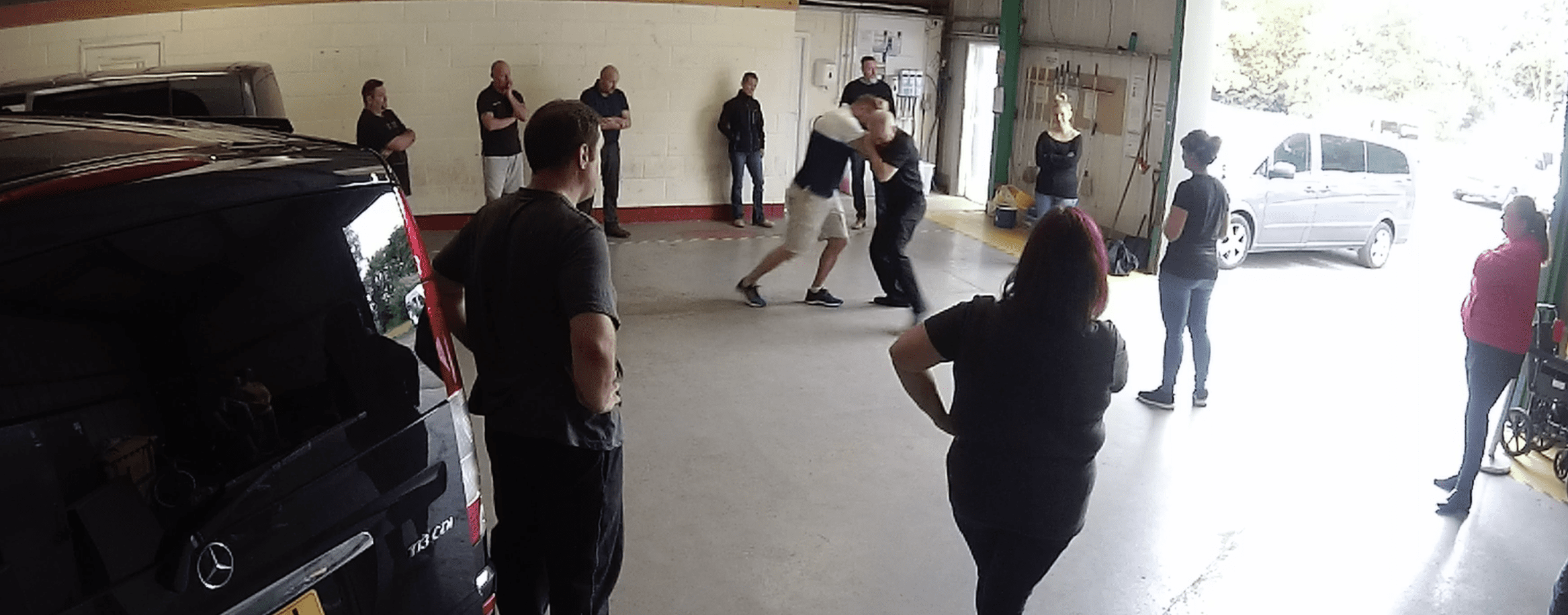
Why do Secure Transport teams need training in aggression and violence management?
The job role is pretty intense - secure escort teams may be working with people who don't have the normal inhibitors to violence that most of us in society have. That's why the person they are escorting are in a mental health hospital or prison; they don't always operate on the same social contract as others.
There are two main problems: violence, but also the risk of absconding.
If a sectioned patient manages to run away, the team will be in breach of its duty of care to the patient and to the public of keeping everyone safe. Absconding can be really serious. For example there was once an incident in a vehicle when a patient attacked the patient transport crew. They had to escape from the vehicle and the patient then stole it, drove it the wrong way up a dual carriageway, had a head on collision and died. So when you ask, "What can go wrong?”, it could be really serious.
This is why in our training needs analysis, we believe the teams need a multiple-day training course, because they need to make sure everyone stays safe in a dynamic environment, working with very different characters and risks on each new task. It's a really challenging job and it's definitely not for everyone.
What does training for a secure escort include?
We use a well-known model called “Detect, Defuse and Defend”. When managing people with serious mental illness you've got to be able to detect issues as early as possible.
There are two main ways teams can detect threat - both involve a thorough understanding of the importance of risk assessment, which we cover in the course. First there’s a strategic risk assessment, which is done by the ambulance service and the hospital staff. That's normally documented. And secondly then there are dynamic risk assessments which are done ‘in situ’, when a crew arrives for a job with their documented risk assessment, but they notice the patient is presenting very differently. Teams have to make good decisions based on those two risk assessments and we teach them how to do that.
Developing verbal skills is also a key part of training for secure escort teams. We teach our learners how to use the ‘persuasion sequence’ in order to defuse escalating tension, ensure co-operation and keep everyone safe. We work through a range of scenario-based exercises that have the team rehearsing these verbal skills (from our partner company Vistelar) until they are embedded in their practice.
For example, informal patients may need to be persuaded to do something that’s in their best interest - for example having a painful tooth seen to by a dentist. The Vistelar persuasion sequence appeals to logic and emotions in a respectful way and helps escort teams achieve co-operation without escalation to verbal or physical confrontation.
Increasing the intensity, we might run a scenario where risk assessments indicate a patient is known for violence, therefore they should travel in a specialised area in the back of an escort vehicle. It is not a very nice invitation to give somebody! So the art of persuasion is absolutely key to defusing conflict in high-risk situations like these.
We are always aiming to de-escalate situations as rapidly as possible, using force only where we must, as a last resort. We also teach and practice the physical skills - defend - which a secure escort team may have to use when, for example, all other means of achieving the safe co-operation of the violent patient above have been exhausted.

What verbal skill is most important for a secure escort team?
In our experience, the persuasion sequence is the most useful tactic for Secure Escort teams. When it comes to conflict and violence, prevention is obviously better than cure. Our Vistelar method for not-escalating everyday encounters, de-escalating high-stakes encounters and being sensitive to people who need crisis management is really on-point.
On the first day of training, the focus is on non-escalation. We focus on how teams present themselves through using what is called the ‘universal greeting’, and then how they make the initial request for a patient to come to sit in the back of the vehicle for example. The ‘how’ they do that is critical - how they introduce themselves and their team, and explain the ‘why’ behind their request and then how they move into the de-escalation phase if they meet resistance.
Through scenario based training the team develop their skills in using the persuasion sequence, as well as the skills of listening, empathising and redirecting. And then we bring in crisis management for when situations are going really badly - those situations require different management.
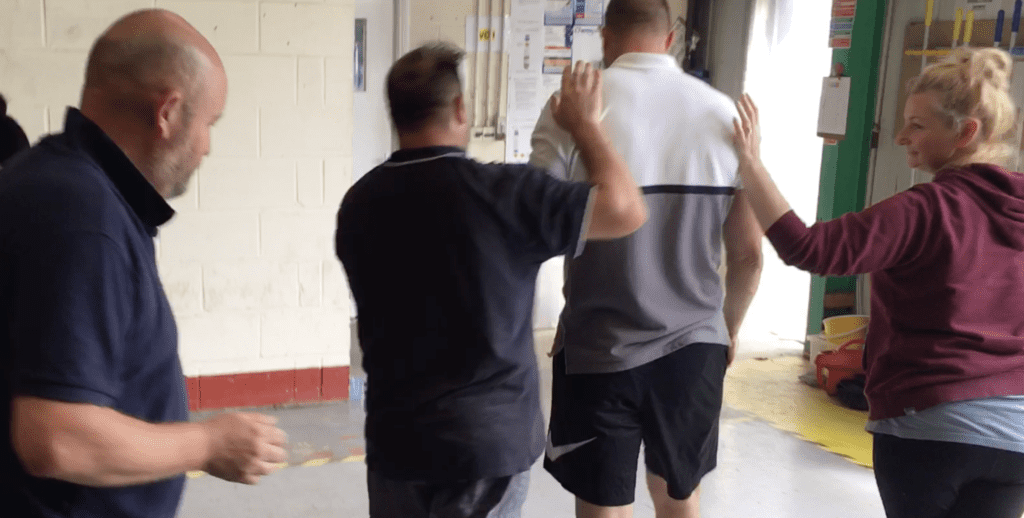
How does a secure transport team know when a situation moves to crisis management?
Crisis is when an individual is out of control of their own behaviour to a point of dysregulation. They are not coping with the situation.
Before this, the individual may be escalating to a certain level, but their thinking brain is still working. Secure escort teams can communicate in a fairly normal way with them. However at crisis point not very much is getting through. The cognitive, rational brain is being so hijacked by the limbic system, the survival brain, that the individual can't think straight anymore and they're in a pure survival mode of fight, flight or freeze. It's like a big abyss is just opening up in front of the person because they're in crisis.
We delve into the ‘why's’ of this in our training course. It is important for the team to understand the nature of the behaviour - why is the individual behaving in this way or saying ‘no’? What’s the function of it? There's always a reason.
In the training we focus on considering each scenario and using the contextual clues to evaluate what that reason might be. If escort officers can see the individual’s point of view, they are not so drawn in by displays of challenging behaviour; they can stay calmer, get more creative with identifying and acknowledging the individual’s unmet need, express their need and find a solution to the problem. That’s the dance of communication - all of which happens before the crisis point.
But at the crisis point, safety overrides everything else. The main objective now is not about building rapport and understanding, but becomes about safety and the need to slow the service-user down. Their heartbeat could be 150 beats plus per minute when there's adrenaline in their system, even if they are sitting perfectly still. Their thoughts are racing, their heartbeat is racing, all that stress is building, building, building.
In the training the team practice scenarios where the emphasis changed to talking quietly, saying less, giving the individual physical space if possible and modelling calmness - all of which help to reduce stimulation.
The average person who responds to somebody in crisis often does the opposite of these things. Because they want to help, they get really close, they talk a lot to try and reassure, they might even give the individual a reassuring touch. And that can actually make the conflict worse because it overstimulates.
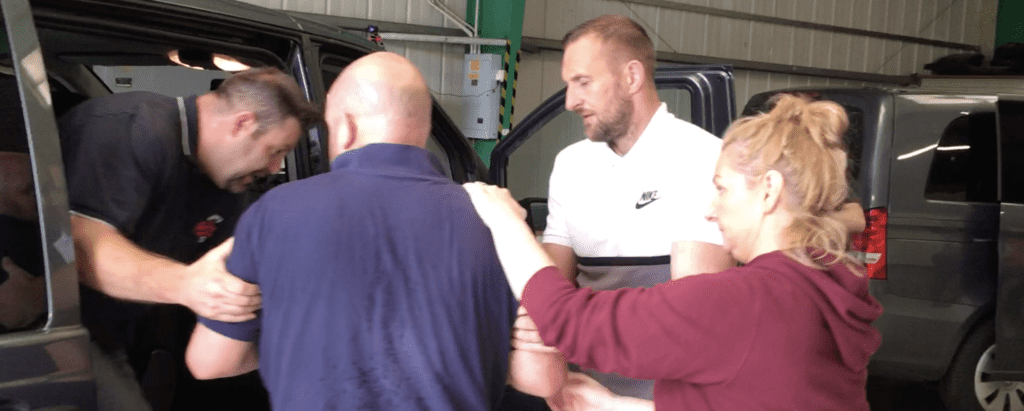
How does scenario training help secure escort teams?
When it comes to teaching conflict management, you can’t just talk about it. As Gary Klugewicz at Vistelar says: ‘are you going to talk about the fire drill or actually practice the fire drill?’ There's a big difference.
Practice doesn't necessarily make perfect, but it does make permanent. The more our learners actually practice those non-escalation, de-escalation and crisis management skills, the more they become habitual. So for example in our training, we have learners doing the whole task from start to finish in the morning of day one.
First we go through the theory of non-escalation with learners. They practice adopting the ‘showtime mindset’ before introducing themselves to a patient using a universal greeting and adopting appropriate body language.
In the scenarios on module one the patient is compliant. They say, "Okay, sure. I'll come with you." The team practice their positioning - where to stand when that patient is being guided and escorted from the hospital to the vehicle. Then we introduce the procedure of getting them inside the vehicle, bearing in mind they could run away or attack at any minute. Learners were always thinking about those two things and managing them through each scenario.
After that the scenarios focus on managing the individual inside the vehicle, getting them out of the vehicle at the other end of the journey and escorting them to where they need to be.
Then the practice of what we call ‘closure’ is folded in. However the scenario plays out the secure escort team had to complete a positive closure, so if they see that individual again the interaction is not going to pick up from a negative place.
To begin with, the learners knew what the scenario would be and how it would run. But around half way through module one, we introduce escort staff to the ambush moment: where in a given scenario, their patient tries to run away or assault someone in the team.
From module two, the patient behaviour becomes more challenging. Scenarios start to encompass the passively resistant, then actively resistant patient.
As an example of passive resistance, escort staff may invite a patient to come with them and the patient says, "Yeah, I'll go in a minute," but it’s questionable if they are going to move or not. This is probably the most challenging of all responses. If somebody's actively resisting the team by attacking them, at least it’s clear where they stand. But this is really quite difficult.
This is complicated further if it is an informal patient who becomes passively resistant - escort staff are not permitted to use physical force if they do this. They would be permitted to with a sectioned patient, but they only want to use force as a last resort, because things will get worse before they get better in that case.
So on module two, escort staff begin using low level, physical control methods in response to an attack or attempt to run away.
By module three, we ratchet the risk up a level. In these scenarios, the holds from day two aren't enough to gain control of the individual because the person is too big or too strong or too adrenalised. This involves learning how to stabilise the individual in different, but higher-risk holds and tactics, to match the physical risk.
From here, handcuffing is introduced as a means to reduce the amount of time the patient is in any higher-risk position, minimising the risk of medical complications from restraint, and get them safely into a vehicle. The team also practice compliant handcuffing - handcuffing which is required from the beginning of an encounter with a patient who has a high risk of violence or has tried to abscond several times before.
Finally, on module five, the scenarios are basically ‘freestyle’. The ‘patient’ is briefed to display any of the behaviours covered in the training: running away, attacking, passive, actively resistant or just compliant. That last one often catches people out - you can see the team waiting for an ambush moment - and it never comes! There’s important learning in that too.
The running-away scenario often tends to catch these teams out. The team has to work on the discipline of having their hands ready, so when something does happen their arms would be in the right place to keep everyone safe and prevent the patient absconding or hurting someone.
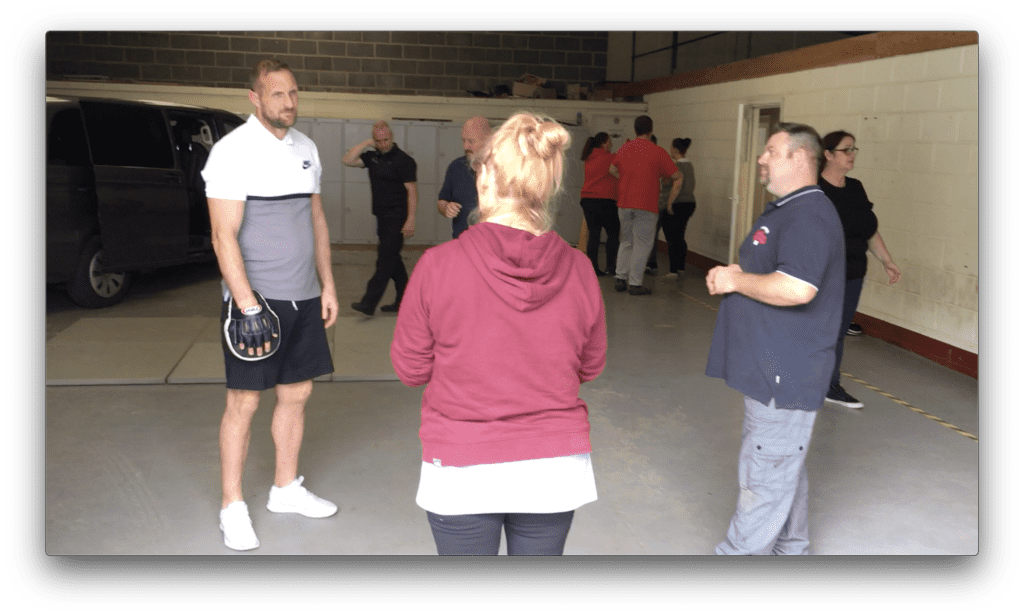
What kind of training is appropriate for secure escort teams?
In secure escort training we focus intensively on replicating and reacting to the behaviours staff are likely to observe in their role. When staff see behavioural warning signs they know that’s their cue to use the verbal and physical skills they learn on this training.
A big challenge is replicating the different environments for scenario training with secure escort staff. It's difficult to set up something to replicate the hospital, something to replicate the part between the hospital and your vehicle, as well as the vehicle itself. We can't do any scenario training when actually driving, but ideally we should because in the real world issues do erupt suddenly in the back of the transport vehicles.
Organisations can help to enhance the training even further by sourcing a venue which replicates their people’s working environment as closely possible, within the parameters of safety. Making the training environment as ‘real’ as possible will mean more effective practice and deeper learning for staff - which is then more easily retrieved and put into action in live situations.
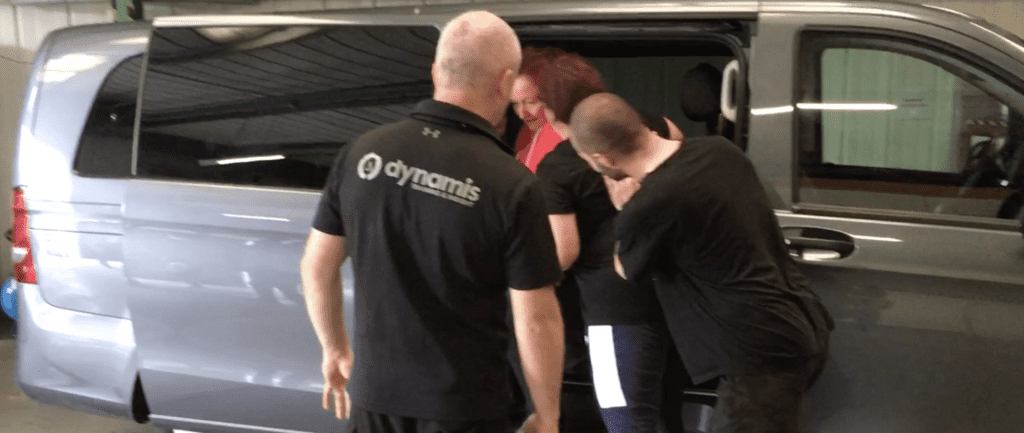
What kind of staff become secure escorts?
A lot of secure escort staff are very experienced. For example we see ex- police officers, others had done nightclub door-work in inner city areas for 30 years, so they've seen a lot. Some come from a mental health background, or support work. Some of the younger members of staff come in to the work and it may be their second ever job, so they are fresh and bring their own perspectives to the training.
Our learners often appreciate the unique aspects of the Dynamis course compared to previous training they receive: for example the training’s emphasis on using verbal skills, the intensive scenario practice based on real experiences and that the physical skills are actually functional, they work for real and our feedback reflects that.
Read some feedback about this course from our clients:
https://www.dynamis.training/secure-escort-training-feedback-from-frontline-staff-and-management/
Also:
https://www.dynamis.training/cpd-secure-mental-health-ambulance-escort-team/
and:
https://www.dynamis.training/secure-patient-transfer-and-mental-health-transport/


